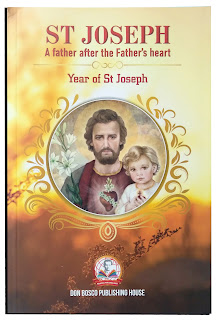God of Surprises (Book Review)
God of Surprises,
Gerard. W. Hughes, Mumbai: St Paul
Publications, 1990, ISBN 81-7109-091-5, Rs. 35, pp. 162.
This is a guidebook for the journey of life which began at
conception and will end at death. It is written especially for bewildered,
confused or disillusioned Christians, who have a love-hate relationship with
the Church. God is a ‘God of Surprises’ because He is not remote or distant,
dwelling only in tabernacles and temples of stone, but near to us. Smiling and
waiting to embrace us despite our confusion, bewilderment, anger etc. This book
aims to suggest some ways of detecting the hidden treasure in what may be
considered a most unlikely field, oneself.
The treasure is within us. The First Chapter illustrates
this premise. The treasure lies hidden in our inner moods and feelings. Many
people live without getting in touch with their inner selves. Our inner selves
can tell us the direction our lives should take and supply the inspiration and
energy to take it. If the inner life is ignored, violence erupts in some form
or the other. Religion, as it is often presented and understood, not only fails
to give importance to the awareness of one’s inner self, but even actively
discourages it.
The Second Chapter shows us how we can get in touch with our
inner selves. The author presents von Hügel’s analysis of the three main stages
of human development-infancy, adolescence and adulthood-describing the
predominant needs and activities which characterize each stage. The growth of
faith and its connection with these stages is also presented.
The Third Chapter deals with the ups and downs of our inner
selves and false images of God we may have. Our inner life is at times chaotic
and seemingly dangerous. Some of the feelings and emotions we discover could wreck
us if we let them take control of us. How do we deal with them? We need to go
to God and let him illumine our darkness. False images we may have of God,
constructs of our upbringing, experiences or ideas can disturb and stifle us.
Becoming aware of these false images is vital for our growth.
In the Fourth Chapter, the author suggests some methods of
prayer. These methods help us meet the God who is actually out to meet us. Each
of us has our own unique way of praying and hence may find one or the other
method suitable. The suggestions of the author however could be a useful tool
for those struggling to pray. He gives a good variety of methods to choose
from.
Chapter Five shows how the journey is not only made with our
minds and with the religious part of ourselves, but involves our whole being
and affects every aspect of it, our relations to other people, our attitude to
health, wealth, reputation, power, and our reactions to the economic, social
and political structures in which we live.
Repentance is a must if we are to discover the treasure.
Failure to repent is the root cause of many evils. The Sixth Chapter dwells on
this theme and its pivotal role in Christian life. At the end of the chapter,
the author makes a wonderful comparison between the marks of true repentance
vis-à-vis false repentance.
In the Seventh Chapter, the author gives some exercises that
will help us recognize the action of God in our lives and give him praise,
thanks and glory for it. He suggests reviewing one’s consciousness and
imaginative contemplation. At the end of the chapter, he presents some biblical
texts which could be useful for imaginative contemplation.
The Eighth Chapter is devoted to learning to recognize the
treasure when you find it. God is the answer to our inner restlessness and
emptiness. When we approach Him we experience peace, tranquility and joy, but
when we move away from Him the opposite feelings envelope us. The author
presents seven guidelines that help us interpret our moods and feelings.
Chapter Nine is about Christ our treasure, whom we often
take for granted and fail to recognize. The Jews did not recognize him and
sometimes neither do we. This truth is illustrated in a letter written by an
imaginary parish priest complaining of the disruptive behaviour of one of his
parishioners.
Chapter Ten is aptly tilted ‘Knowing Christ’. When people
imaginatively contemplate on the Gospels, they are often surprised by the
Christ they meet. The author gives us some guidelines for reading or
contemplating Christ in the Gospel.
Chapter Eleven focuses on the passion and resurrection of
Christ. Faulty understanding of these two important events in Christ’s life
contribute to producing a distorted image of God and deter us from our
spiritual journey.
We move towards the field and dig towards the treasure
through the decisions we make in everyday life. Chapter Twelve is not a
treatise on decision-making, but offers some basic guidelines for individual
and group decisions.
The Final Chapter
applies the insights of the book to a very real situation- the threat of
nuclear war. In this chapter the author expresses his inner feelings regarding
nuclear war and beautifully presents the Christian approach to nuclear weaponry
and warfare.
The book was well received and was awarded the Collins
Biennial Religious Book Award 1987. The author must be commended for his
down-to-earth presentation and penetrating insights. His Jesuit spirituality
permeates the entire book. Every chapter has the breath of the spiritual exercises.
Ignatius is often invoked as a model. The exercises given at the end of each
chapter helps to interiorize and work on the insights gained. Spiritual growth
is aimed at and if one is serious, one will surely benefit.



Comments
Post a Comment